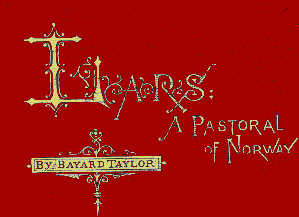Collecting Delaware Books
Lars,
A Hockessin Epic Poem
Joseph Lake Jr.'s Hockessin: A Pictorial History (1976, 1997) is well-known. But Hockessin, Delaware, also was the locale of an epic poem written 130 years ago by one of 19th century America's favorite authors. The story and the poetry may not appeal to modern taste, but the book is a fine piece of Delawareana.
Bayard Taylor (1825 - 1878, born James Bayard Taylor) started his literary career in the 1840s by taking a walking tour of Europe, financed by sending dispatches back to American newspapers. The articles were well received, and he wrote successful travel books the rest of his life. As his fame grew, he added fiction, poetry, and a translation of Goethe's Faust to his output.
Taylor maintained a large home in Kennett Square, Pennsylvania, (about five miles from Hockessin) where other writers were always welcome. Georgia poet and musician Sidney Lanier is said to have spent months at a time there. His compulsive hospitality was a severe financial burden on Taylor.
Taylor is still much revered in Kennett Square. Indeed, some call him the town's patron saint. He is not often remembered in other places except the marijuana community. He wrote a long discourse on his, legal at that time, experiments with "hasheesh" as Chapter X of his travel book The Lands of the Saracen. The text is widely distributed and can be found on the Internet.
Hockessin Poem

Lars A Pastoral of Norway by Bayard Taylor was published by James R. Osgood and Company, Boston, in 1873. There was apparently only one edition. The 144-page book is 5- by 7-inches and bound in dark red cloth stamped in gold with the title and author's name in a gaudy typeface. The pages of most copies are heavily foxed.
The blank verse poem is divided into three "books." Book 1 takes place in a village in Norway. Shepherd Lars and fisherman Per are both courting Brita, who can not decide between them. Per eggs Lars into a fight for Brita, and Per is killed. Brita suddenly decides it was Per she loved.
In Book 2, Lars wanders away disconsolate. He remembers that his great-grandfather was a trooper under Governor Printz in the New World and decides to go there himself. He lands in Philadelphia and wanders down to Wilmington. There he finds people with Norwegian faces, but they no longer speak the language or keep the customs. He wanders north of Wilmington, in an area stated to be Hockessin, and is taken in by a Quaker farmer Ezra Mendenhall and his daughter Ruth. Ruth teaches him to read and speak English, using William Penn's No Cross, No Crown as a text.
Ruth's suitor tries to start a fight with Lars. In the scuffle Lars accidentally injures Ezra. The Ezra forgives Lars in meeting, and Lars embraces the Quaker faith. Eventually Lars and Ruth marry.
Years later, in Book 3, the Ezra has died, and Lars and Ruth are visiting Norway. Per's brother has sworn revenge and challenges Lars to a fight. Lars eloquently declares his Quaker pacifism. Per's brother eventually yields and admits the error of his ways. Meanwhile, Ruth befriends Brita who has been living as a hermit, returns her to society, and converts her to the Society of Friends. Brita becomes an influential speaker and writer in the Norwegian Quaker community that Lars and Ruth establish.
Samples
Lars is easy reading. Seldom is the meaning lost in poetic license. The fight between Per and Lars is violent. An introductory part reads as follows.
When those two backward stepped, all saw the flash Of knives, the lift of arms, the instant clench Of hands that held and hands that strove to strike: All heard the sound of quick and hard-drawn breath, And naught beside but sudden red appeared, Splashed on the white of shoulders and arms.
The marriage of Ruth and Lars is as gentle as the fight is violent.
One winter Sabbath, when in snow and sky The colors of transfiguration shown, Within the meeting-house. There Ruth and Lars Together sat upon the women's side, And when the peace was perfect, they arose. He took her by the hand, and spake these words, As ordered: "In the presence of the Lord And this assembly, by the hand I take Ruth Mendenhall, and promise unto her, Divine assistance blessing me, to be A loving and faithful husband, even Till death separate us." Then spake Ruth The same sweet words and so the twain were one.
Background
Bayard Taylor was not a practicing Quaker. His father was a lapsed member of the Society of Friends, perhaps thrown out because he married a Mennonite. However, Bayard had a secular Quaker upbringing. All his teachers and associates were Quaker. He knew whereof he wrote in the meeting house scenes in Lars. The poem would seem to be an endorsement of Quaker beliefs, however he was critical of the organized religion in other writings.
He paints few word pictures of Hockessin, but he certainly knew the area.
Though a Delaware historian will find little in Lars, the book is a fascinating bit of Delawareana. Copies are scarce, but the demand is light. A nice one can usually be bought for under $100.